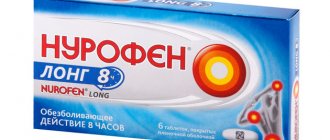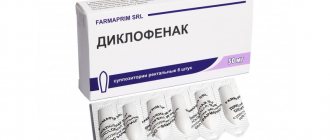"Mig", tablets: analogue
The main active ingredient of this drug is ibuprofen.
This element can have analgesic, anti-inflammatory and antipyretic effects. In addition to Mig tablets, in pharmacies you can find a large number of other drugs that have a similar composition and have the same analgesic effect. Pay attention to these analogues, most often recommended by doctors:
– “Burana”;
– “Nurofen”;
– “Faspik”;
- Nurofen Ultracap.
All of them are very effective and relatively safe. This active component is widely used all over the world to relieve pain.
However, after using this substance, allergies and other adverse reactions may occur, so you should consult your doctor before using it. The same applies to the drug "Mig".
The duration of action of a tablet containing ibuprofen is approximately five hours. In this case, the drug begins to act within ten minutes after use.
In some cases, patients need more effective and efficient remedies. In this case, you should pay attention to drugs containing not only ibuprofen, but also paracetamol.
These include:
– “Next”;
– “Ibuklin”;
- “Brustan”.
These drugs also have analgesic, antipyretic and anti-inflammatory effects. However, they are more effective than drugs containing other active substances.
Pharmacological group
Ibuprofen is a propionic acid derivative. It indiscriminately blocks cyclooxygenase 1 and 2, inhibits the synthesis of prostaglandins, as a result, the drug has an analgesic, antipyretic and anti-inflammatory effect.
The analgesic effect is strongest for pain of inflammatory origin.
Ibuprofen has antiplatelet activity.
After oral administration, the drug is well absorbed from the digestive tract. The maximum concentration of ibuprofen in plasma reaches approximately 2 hours after taking the medication.
Up to 99% of the active substance binds to plasma proteins. The drug penetrates slowly into the synovium and is eliminated from it more slowly than from plasma.
Passing through the liver, the drug undergoes metabolism. The half-life varies from 2 to 3 hours. The drug is excreted primarily through the kidneys.
Fast action due to good composition
The drug is available in the form of white tablets. It is convenient to dose the tablet using a special feature. The medicinal substance includes the following components:
- ibuprofen;
- starch;
- silica;
- sodium salt;
- magnesium stearate;
- macrogol;
- povidone.
The active component ibuprofen affects pain symptoms and reduces inflammation during toothache. Ibuprofen blocks receptors in the dental pulp, thereby reducing inflammation. Additional components that are part of the medicinal substance relax the muscles, thereby reducing tooth sensitivity.
The price of the painkiller Mig depends on the quantity in the package: 10 tablets have an average cost of 70 rubles, 20 tablets 150 rubles.
Freezing drugs
There is a category of people who take medications only in extreme cases, and if they are worried about dentalgia, they can eliminate it with the help of a gel with a freezing effect. These remedies are among the most effective, and they do not cause side effects and have almost no contraindications.
- Both adults and children can use the drug Kamistad based on lidocoine hydrochloride for severe toothaches. It will help relieve pain quickly and for a long time, however, it is not recommended for use by patients suffering from liver or kidney failure, those with high blood pressure, as well as pregnant and lactating women.
- Dentol relieves pain well not only in adults, but also in the youngest patients whose first teeth are just erupting.
- The drug Metrolgin Denta relieves pain syndromes associated with periodontitis, stomatitis, periodontal disease, pain and inflammation of teeth.
Quite often, toothache occurs in pregnant women. The use of medications, especially painkillers, is strictly not recommended during this period, as they can affect the development of the fetus by penetrating the placental barrier.
If a pregnant woman has a toothache, it is best to try to eliminate the pain with the help of traditional medicine. Compresses and mouth rinses will help relieve pain. In case of severe dentalgia, you can take certain medications.
The drug Ibuprofen relieves severe tooth pain. You can take one tablet first, but if the pain does not disappear, take another one after four hours. During pregnancy, it is allowed to use drugs such as Baralgin, No-shpa, Analgin, Spazmolgon against dental pain.
You should avoid using any medications in the first trimester of pregnancy to avoid fetal malformations. The second trimester is a safer time for the fetus, when medications are allowed if necessary. In the last months, some medications can trigger premature labor.
Instructions for use and dosage selection
“Mig” are tablets that effectively cope not only with headaches, but also with pain of any etiology. The medicine is taken orally. In this case, the dosage is set individually, depending on the patient’s condition and his illness.
We suggest that you familiarize yourself with Pain in the cheekbone area of the face
Please note that the medicine can be used by adults and children over twelve years of age. You should start taking the drug with a minimum dose, which is 200 mg three to four times a day.
In some cases, the dosage may be increased to 400 mg at a time. After the therapeutic effect is achieved, the daily dose can be slightly reduced. Your attending physician will advise you in more detail.
Please note that Mig are tablets that are taken for a short period of time. Most often, doctors advise using this drug for a week, after which its use should be stopped. You should also not increase the dosage on your own. If this is necessary, your doctor will tell you about it.
If you suffer from impaired liver and kidney function, do not forget to tell your doctor about it. In this case, the dosage will be reduced.
Directions for use and dosage
Mig-400 is taken during or after meals with water. One tablet contains 400 mg of active ibuprofen - this is a sufficient amount for safe pain relief. Used in adults and children over six years of age, weighing more than 20 kg, without repeating a single dose earlier than six hours later.
- A single dose for children over 6 years of age (20-29 kg) is 1/2 of a tablet, maximum three times a day with an interval of six hours.
- For children 10-12 years old (30-39 kg) - a single dose is 1/2 tablet, with a maximum of four daily doses with an interval of six hours.
- Adults and children over 12 years of age (from 39 kg) should select the dosage depending on the severity of the pain syndrome (from 1/2 to 1 tablet for a single dose), but no more than three tablets per day.
You should not take the drug for more than four days; it is better to use Mig-400 in short courses in emergency cases.
READ ALSO: Which tablets are best for relieving toothache?
How to take Mig tablets for toothache
Mig 400 tablets containing four hundred milligrams of ibuprofen are taken orally. The choice of the most optimal regimen is carried out individually for each patient, taking into account the characteristics of the clinical picture.
This drug can be taken by both adults and children. The tablets should be swallowed whole, without chewing, with water. You can take the medicine either during or after meals.
For patients of childhood and adolescence, the dosage should be determined taking into account the fact that per kilogram of weight there should be no more than ten milligrams of the main active component of the drug.
So, a child from six to nine years old can be given half a tablet of the drug no more than three times a day. For children from ten to twelve years old, a single dose is also half a tablet with a maximum daily dose of eight hundred milligrams.
Children over twelve years of age and adults can take a whole tablet each time - so that no more than 1200 milligrams of ibuprofen enter the body during the day.
It is advisable that the time interval between taking Mig tablets be at least six hours. The maximum duration of the course of taking the drug is four days.
An overdose of the drug, as well as taking it for too long, increases the risk of negative effects of ibuprofen on the body.
How to take mig 400 tablets for toothache
The ibuprofen contained in these tablets is quite quickly absorbed from the human digestive system and, spreading in the blood and synovial fluid, affects areas of inflammatory processes. The high concentration of ibuprofen in the synovial fluid and its relatively slow removal from it ensures the high effectiveness of the drug for inflammation of the joints.
The high rate of absorption of the drug when it enters the gastrointestinal tract ensures the rapid onset of the analgesic effect - the drug begins to act within ten minutes after its use.
After ibuprofen penetrates the body, this substance is metabolized in the liver with the formation of metabolites that do not exhibit pharmacological activity, which are removed in the urine and bile. Metabolism of the drug is an additional burden on the liver.
Therefore, if you have liver problems, Mig 400 tablets should be used with caution. In severe pathologies of this organ, ibuprofen is completely contraindicated.
For the same reason, while regularly taking ibuprofen, it is highly undesirable to drink alcohol or use other drugs that also overload the liver.
Side effects
Like other non-steroidal anti-inflammatory drugs, Mig 400 tablets can cause disturbances in various body systems.
Digestive system disorders can manifest themselves with various symptoms, among which the most likely development is vomiting, abdominal pain, flatulence, nausea, heartburn, diarrhea, and constipation. In rare cases, ulceration of the gastrointestinal mucosa may occur, complicated by bleeding and perforation. If signs of bleeding appear in the gastrointestinal tract, Mig 400 should be discontinued. In addition, disorders may manifest as:
- Pain in the mouth;
- Pancreatitis;
- Irritation or dryness of the oral mucosa;
- Aphthous stomatitis;
- Ulceration of the mucous membrane of the gums;
- Hepatitis.
Nervous system disorders when taking Mig 400 tablets most often manifest themselves in the form of:
- Headache;
- Nervousness and irritability;
- Insomnia;
- Dizziness;
- Psychomotor agitation;
- Anxiety;
- Depression;
- Drowsiness;
- Hallucinations;
- Confusion.
Disorders of other body systems during therapy with Mig 400, according to the instructions, include:
- Bronchospasm and shortness of breath (respiratory system);
- Tachycardia, heart failure, increased blood pressure (cardiovascular system);
- Toxic damage to the optic nerve, hearing loss, blurred vision or double vision, ringing or noise in the ears (sense organs);
- Anemia, agranulocytosis, thrombocytopenia and thrombocytopenic purpura (hematopoietic system);
- Allergic nephritis, acute renal failure, polyuria, nephrotic syndrome, cystitis (urinary system).
Long-term use of Mig 400 tablets in high doses increases the risk of bleeding (gastrointestinal, uterine, gingival, hemorrhoidal) and visual impairment.
During treatment with Mig 400, the most likely allergic reactions are:
- Bronchospasm or dyspnea;
- Quincke's edema;
- Eosinophilia;
- Skin rash and itching;
- Exudative erythema multiforme;
- Anaphylactic shock;
- Anaphylactoid reactions;
- Fever;
- Toxic epidermal necrolysis;
- Allergic rhinitis.
Painkillers
- Ketanov tablets are considered the best remedy for toothache. They contain ketorolac, which is responsible for eliminating painful sensations. Although the medicine is considered non-hormonal, it should be used with caution. Ketanov should not be taken by children under 16 years of age, pregnant and lactating women, as well as people suffering from bronchial asthma. Taking the pill may cause side effects such as drowsiness, dry mouth, nausea, and dizziness.
- The drug Nise will help get rid of severe toothache. This is a powerful medicine, which is imported from India, and in just a few minutes it relieves even the most severe toothache of various origins. The drug is prescribed for neuralgia, inflammatory processes, and infectious diseases. Only one tablet is recommended to be taken for very acute pain. The effect of the medicine lasts for 6–8 hours. After taking the drug, in some cases a skin rash, stomach pain, and nausea appear. Pregnant women should not take the drug.
- Ketarol is a strong pain reliever. You are allowed to take up to three tablets per day. A quick effect is achieved when the medicine interacts with a large amount of liquid, so it is washed down with a whole glass of water.
- Bral tablets cope well with pain of mild to moderate intensity. The daily dose should not exceed six tablets. After taking, the possible development of allergic reactions, increased heart rate, chills, decreased temperature and pressure. The drug does not combine well with other medications.
We invite you to familiarize yourself with Inexpensive painkillers: list, description
Tablets from this group will help not only soothe pain, but also relieve inflammation.
- The drug Actasulide is considered one of the most popular anti-inflammatory drugs. You should be careful with it, as it has a number of contraindications. Children under 12 years of age, pregnant women, and persons suffering from diseases such as kidney, liver, heart failure, ulcers, and diabetes should not take the tablets.
- Ketonal tablets very quickly relieve pain syndromes and have an anti-inflammatory, antipyretic, and analgesic effect. The drug should not be taken by children under 15 years of age. It is worth paying attention to the fact that side effects may occur - increased fatigue, nervousness, drowsiness, headache, vomiting, diarrhea, nausea.
- Nurofen is considered one of the most effective painkillers. The tablets not only eliminate pain, but also relieve inflammation of the gum tissue. The main active ingredient is codeine. The drug is available without a prescription, but before use you should read the instructions to avoid unpleasant consequences. It is strictly not recommended to take Nurofen tablets if you have Crohn's disease, hypertension, liver or kidney diseases.
- Mig tablets are an effective anti-inflammatory non-steroidal medicine that helps relieve pain and fever. You can take them for a week, 0.5 tablets three times a day. Do not use by pregnant women, as well as persons suffering from diseases of the optic nerve, blood, ulcers and bleeding.
A moment for toothache – will a pill help with toothache?
One of the most severe pains a person can experience is toothache. It can be aching, shooting, but, in any case, it is not always possible to tolerate it. Common causes of acute pain:
- pulpitis (characterized by night pain);
- periodontitis (aching pain that turns into intense pain if left untreated);
- periostitis or flux (severe pain, may be accompanied by fever and swelling of the cheek);
- tooth abscess (pronounced pain syndrome, in which even the strongest analgesics are ineffective).
If acute painful sensations appear, you should not postpone a visit to the dentist, as they are always the cause of inflammatory diseases. The drug Mig-400 will help you survive the pain before visiting the dentist.
Effect of the drug Mig-400
The main active ingredient of the drug is ibuprofen, which has analgesic, antipyretic and anti-inflammatory effects. The unique production technology allows the tablet to dissolve in the gastrointestinal tract within 5 minutes, so the analgesic effect develops very quickly. The drug has proven safety and effectiveness.
Indications for use
This is a universal analgesic, antipyretic, anti-inflammatory drug. Belongs to the group of NSAIDs (non-steroidal anti-inflammatory drugs). Used for the following types of pain:
- headache, including migraine;
- dental, any intensity;
- articular and muscular;
- periodic in women;
- effective for colds accompanied by increased body temperature, fever, chills and body aches;
- neuralgia.
Can tablets be used for toothache?
Many people, trying to get rid of pain, use all sorts of folk methods, such as using lidocaine solution, rinsing and applying special drops, and even applying the tablet form of Analgin to a sore tooth.
READ ALSO: how and how long does it take for Analgin to work for toothache?
You need to know that a tooth consists of bone tissue, which cannot hurt. Pulp tissue containing nerve endings sends signals to the brain about damage.
Analgesic drugs block the nerve endings and the tooth stops hurting.
It follows from this that the drug Mig-400, being a modern analgesic, helps with pain syndrome; its action is most effective for pain of inflammatory origin, which includes toothache.
Directions for use and dosage
Mig-400 is taken during or after meals with water. One tablet contains 400 mg of active ibuprofen - this is a sufficient amount for safe pain relief. Used in adults and children over six years of age, weighing more than 20 kg, without repeating a single dose earlier than six hours later.
- A single dose for children over 6 years of age (20-29 kg) is 1/2 of a tablet, maximum three times a day with an interval of six hours.
- For children 10-12 years old (30-39 kg) - a single dose is 1/2 tablet, with a maximum of four daily doses with an interval of six hours.
- Adults and children over 12 years of age (from 39 kg) should select the dosage depending on the severity of the pain syndrome (from 1/2 to 1 tablet for a single dose), but no more than three tablets per day.
You should not take the drug for more than four days; it is better to use Mig-400 in short courses in emergency cases.
READ ALSO: Which tablets are best for relieving toothache?
Contraindications and side effects
Before taking the drug, you must carefully study the instructions. The medication is well tolerated, but there are contraindications:
- increased sensitivity and individual intolerance to components;
- reaction in the form of bronchospasm and allergic rhinitis to aspirin derivatives;
- ulcerative lesions of the gastrointestinal tract and duodenum, gastric erosions, gastrointestinal bleeding in the active phase, acute intestinal inflammation;
- impaired blood clotting and related diseases;
- severe forms of heart, liver and kidney diseases;
- pregnancy and children under six years of age.
Sometimes side effects occur:
- From the gastrointestinal tract: heaviness in the stomach and all kinds of disorders of the digestive tract and pancreas, minor bleeding, colitis.
- Sense organs and central nervous system: tinnitus, vision changes, headache and dizziness. In rare cases, bronchospasm and anaphylactic shock have occurred.
- Cardiovascular system and hematopoietic system: hypertension, rapid heartbeat, heart failure, various hemorrhages, decreased hemoglobin and platelets in the blood, leukopenia.
- From the kidneys and urinary system: edema, nephritis, renal failure, high levels of uric acid in the blood plasma.
- Skin reactions: dry skin, rashes, itching. Use with caution for chickenpox, erysipelas, and herpes zoster.
Analogs
Mig-400 tablets are produced in Germany. The drug has been widely studied and has proven effectiveness. There are a number of drugs with similar active ingredients:
- Nurofen;
- Brustan;
- Buran;
- Ibuprofen;
- Bonifen;
- Artrocam.
When choosing, you should not focus on low prices - choose trusted manufacturers.
Experts' opinions
Experts, including dentists, note that Mig-400 is a drug with a pronounced analgesic effect.
Quickly copes with dental pain, including after surgical interventions. It acts instantly and relieves pain for 6-8 hours.
Doctors recommend using the drug not often, but in cases where it is not possible to get an appointment with a doctor in a timely manner.
READ ALSO: How to quickly relieve severe toothache at home?
Source: https://pro-zuby.com/sredstva/ot-zubnoj-boli/mig-ot-zubnoj.html
Indications for use
Mig tablets for headaches actually have a fairly wide range of applications. The medicine is very popular among people suffering from pain. According to the instructions for use, the drug will very quickly cope with the following types of pathologies:
– severe headache (including migraine);
– the medicine will treat even severe toothaches, which not all painkillers can cope with;
– pain in joints and muscles;
– this medication is an excellent assistant for women during menstruation;
– can be used for fever during flu or cold.
Mig tablets for headaches really do their job very quickly, but they do not eliminate the very cause of the disease that is bothering you. Therefore, if you experience regular pain, be sure to consult a doctor. Long-term use of painkillers cannot lead to anything good.
No matter how sad it may sound, not everyone can use the Mig headache remedy, the price of which will be indicated in this article. Let us consider in more detail in what cases taking the drug is strictly prohibited.
– Do not use this medicine if you have severe gastrointestinal ulcers. This also includes patients suffering from Crohn's disease.
– The drug should not be used by patients with hemophilia, as well as with other blood clotting pathologies.
– The product should not be used by persons with bleeding of various origins.
– Contraindications also include pathologies of the optic nerve.
– The tablets should not be used by pregnant and lactating women, as well as children under twelve years of age.
– Hypersensitivity to the active ingredients included in the composition is also prohibited.
In some cases, Mig tablets for headaches, the composition of which is described in this article, can be used with extreme caution and under the strict supervision of a doctor. These include the following cases: diseases of the cardiovascular system, old age, serious pathologies of the kidneys and liver, early stage of intestinal and stomach diseases, some blood diseases, nephrotic syndrome.
Take full responsibility for your health and be sure to read the contraindications before starting to use any medicine.
Contraindications to the use of Mig 400
According to the instructions, Mig 400 cannot be used for:
- “aspirin triad”;
- exacerbation of peptic ulcer, ulcerative colitis, Crohn's disease;
- bleeding of various origins;
- blood clotting disorders, hemorrhagic diathesis;
- diseases of the optic nerve;
- deficiency of glucose-6-phosphate dehydrogenase;
- high sensitivity to the components included in the drug, acetylsalicylic acid, other NSAIDs;
- pregnancy and lactation;
and also up to 12 years.
Mig 400 tablets are used carefully for:
- liver cirrhosis accompanied by portal hypertension;
- arterial hypertension;
- heart failure;
- nephrotic syndrome;
- renal and liver failure;
- a history of peptic ulcer disease;
- gastritis;
- colitis;
- enteritis;
- leukopenia and anemia;
- hyperbilirubinemia;
as well as in old age.
Advantages and disadvantages
Eliminating toothache with Mig has the following advantages:
- the effect of the drug lasts for 6 hours;
- the tablets do not irritate the gastric mucosa;
- the effect of the drug is achieved in a short time thanks to the shell, which quickly dissolves in the stomach;
- the medicine has the ability to reduce elevated body temperature resulting from the inflammatory process.
Disadvantages of the drug in the treatment of pain:
- may contribute to the appearance of adverse symptoms;
- the tablet is large, which can cause difficulties in use;
- the drug has an analgesic effect, but does not eliminate the cause of the pain.
The Mig anti-toothache remedy can be used for a short period of time. If unpleasant symptoms do not decrease, you should consult a dentist.
Tablets for toothache
Toothache can be relieved with medications.
But you should be careful with them, because painkillers are very toxic and, if used incorrectly or in excess of the dose, can cause harm to health.
When using over-the-counter toothache tablets, you should first read the instructions and follow the recommendations for use.
We suggest that you familiarize yourself with Antibiotics for toothache, inflammation of the gums, tooth roots and periosteum - Beautiful smile
Your first aid kit should always contain medications for toothache, because the problem can arise unexpectedly, but getting rid of it is very difficult.
It is important to remember that medications cannot cure a tooth; they only relieve pain for a while. If you experience systematic dental pain, you should consult a dentist, and the sooner the better.
Only after curing diseases of the oral cavity will the patient be free from pain for a long time.
How much does it really help: is Mig effective for toothache?
Toothache is debilitating and makes it difficult to concentrate on simple everyday tasks. It turns even the most friendly and active people into irritable and incapacitated people.
But despite the fact that experts do not recommend constantly treating toothache with anesthetics, delaying a visit to the dental office, sometimes it may simply not be possible to visit a doctor immediately.
Painkillers, which abound in the pharmacological market, come to the rescue. The drug Mig is one of the most popular medicines that relieve toothache.
ontakte
Odnoklassniki
Mig is sold in the form of film-coated tablets with a double-sided score for easy division. The product is available without a prescription .
Composition – the drug contains the active ingredient – ibuprofen.
Important! Ibuprofen is included in the list of essential medicines of the World Health Organization; it is also present in the list of vital drugs , which was approved by the Government of the Russian Federation in 2009.
It should be noted that the mechanism of action of this substance is well studied, and its effectiveness has been proven by clinical trials conducted under the supervision of reputable laboratories. Excipients contained in the drug: corn starch, sodium carboxymethyl starch, colloidal silicon dioxide, magnesium stearate.
Pharmacodynamics
Thanks to this composition, Mig effectively copes with pain (including dental pain), fever and inflammation, and the analgesic effect is most pronounced specifically for pain caused by the inflammatory process.
The mechanism of action of the drug is associated with the suppression of the biosynthesis of prostaglandins E and F. We are talking about physiologically active substances that increase the sensitivity of specific receptors to pain mediators (histamine and bradykinin). Mig reduces the production of these substances, completely or partially blocking pain.
There is evidence that ibuprofen stimulates the production of interferon, and this significantly increases the body's resistance to viruses and bacteria, in other words, helps strengthen the immune system.
Indications for use
- headache ;
- toothache ;
- menstrual pain;
- pain in joints and muscles;
- neuralgia (trigeminal nerve, external cutaneous nerve of the thigh, pterygopalatine ganglion, glossopharyngeal nerve, occipital nerve, intercostal neuralgia);
- migraine;
- symptomatic treatment for influenza and colds.
Important! Thanks to the special composition of the auxiliary components contained in the drug, the active substance is quickly absorbed, and the analgesic effect begins to develop within 10 minutes and lasts up to 4–5 hours even with intense pain.
Toothache tablets for children
Tooth pain can occur not only in adults, but also in children. When a child has a toothache, it causes trouble for both the baby and the parents. As a rule, children do not like dentists and do not always agree to open their mouths, especially in severe pain.
Therefore, before visiting a doctor, parents try to somehow help the child and calm down the pain syndrome. It is especially difficult to cope with painful sensations during the period when teeth are just beginning to cut. If folk remedies do not help, then you need to use a painkiller tablet.
The problem is that not all drugs can be taken in childhood.
Children can be given medications based on paracetamol or ibuprofen. Rectal suppositories are perfect for infants, and for older children - suspensions, syrups, tablets that will help eliminate toothache.
Contraindications
The drug should not be taken if the patient has the following diseases:
- erosive and ulcerative pathologies of the digestive system, including gastric and duodenal ulcers, nonspecific ulcerative colitis, granulomatous enteritis;
- "aspirin triad";
- bleeding of various origins;
- pathology of the optic nerve;
- hemorrhagic diathesis;
- hemophilia and other problems with blood clotting, including slow blood clotting;
- individual intolerance to the composition of the medication, aspirin and other non-steroidal anti-inflammatory drugs;
- deficiency of glucose-6-phosphate dehydrogenase.
The drug should be taken with caution in elderly patients, as well as those suffering from the following diseases:
- heart failure;
- high blood pressure;
- liver cirrhosis, which is accompanied by portal hypertension;
- increased levels of bilirubin in the blood;
- renal and liver failure;
- inflammation of the mucous membrane of the stomach, small and large intestine;
- nephrotic syndrome;
- blood pathologies of unknown origin (decreased hemoglobin and leukocytes).
Pharmacokinetics
Suction
After oral administration, the drug is well absorbed from the gastrointestinal tract. Cmax of ibuprofen in plasma is approximately 30 mcg/ml and is achieved approximately 2 hours after taking the drug at a dose of 400 mg.
Distribution
Plasma protein binding is about 99%. It is slowly distributed in and cleared from synovial fluid more slowly than from plasma.
Metabolism
Ibuprofen is metabolized in the liver primarily by hydroxylation and carboxylation of the isobutyl group. Metabolites are pharmacologically inactive.
Removal
It is characterized by two-phase elimination kinetics. T1/2 from plasma is 2-3 hours. Up to 90% of the dose can be found in the urine in the form of metabolites and their conjugates. Less than 1% is excreted unchanged in urine and, to a lesser extent, in bile.
Mig 400
◊ Film-coated tablets
white or almost white, oval, with a double-sided scoring line and “E” and “E” embossed on both sides of the scoring line on one side.
Excipients: corn starch – 215 mg, sodium carboxymethyl starch (type A) – 26 mg, colloidal silicon dioxide – 13 mg, magnesium stearate – 5.6 mg.
Shell composition:
hypromellose (viscosity 6 mPa×s) – 2.946 mg, titanium dioxide (E171) – 1.918 mg, povidone K30 – 0.518 mg, macrogol 4000 – 0.56 mg.
10 pieces. – blisters (1) – cardboard packs. 10 pieces. – blisters (2) – cardboard packs.
pharmachologic effect
Non-steroidal anti-inflammatory drug (NSAID). Ibuprofen is a derivative of propionic acid and has analgesic, antipyretic and anti-inflammatory effects due to the non-selective blockade of COX-1 and COX-2, as well as an inhibitory effect on the synthesis of prostaglandins.
The analgesic effect is most pronounced for inflammatory pain. The analgesic activity of the drug is not of the narcotic type.
Like other NSAIDs, ibuprofen has antiplatelet activity.
Pharmacokinetics
Suction
After oral administration, the drug is well absorbed from the gastrointestinal tract. Cmax of ibuprofen in plasma is approximately 30 mcg/ml and is achieved approximately 2 hours after taking the drug at a dose of 400 mg.
Distribution
Plasma protein binding is about 99%. It is slowly distributed in and cleared from synovial fluid more slowly than from plasma.
Metabolism
Ibuprofen is metabolized in the liver primarily by hydroxylation and carboxylation of the isobutyl group. Metabolites are pharmacologically inactive.
Removal
It is characterized by two-phase elimination kinetics. T1/2 from plasma is 2-3 hours. Up to 90% of the dose can be found in the urine in the form of metabolites and their conjugates. Less than 1% is excreted unchanged in urine and, to a lesser extent, in bile.
Indications
- headache;
- migraine;
- toothache;
- neuralgia;
- pain in muscles and joints;
- menstrual pain, fever due to colds and flu.
Contraindications
- erosive and ulcerative diseases of the organs: gastrointestinal tract (including peptic ulcer of the stomach and duodenum in the acute phase, Crohn's disease, UC);
- “aspirin triad”;
- hemophilia and other bleeding disorders (including hypocoagulation), hemorrhagic diathesis;
- bleeding of various etiologies;
- deficiency of glucose-6-phosphate dehydrogenase;
- optic nerve diseases;
- pregnancy;
- lactation period;
- children under 12 years of age;
- hypersensitivity to the components of the drug;
- history of hypersensitivity to acetylsalicylic acid or other NSAIDs.
Carefully _
the drug should be used in the following cases: old age; heart failure; arterial hypertension; liver cirrhosis with portal hypertension; liver and/or renal failure, nephrotic syndrome, hyperbilirubinemia; peptic ulcer of the stomach and duodenum (history), gastritis, enteritis, colitis; blood diseases of unknown etiology (leukopenia and anemia).
Dosage
The drug is taken orally. The dosage regimen is set individually depending on the indications.
Adults and children over 12 years old
The drug is prescribed, as a rule, at an initial dose of 200 mg 3-4 times a day. To achieve a rapid therapeutic effect, the dose can be increased to 400 mg 3 times a day. Once the therapeutic effect is achieved, the daily dose is reduced to 600-800 mg.
The drug should not be taken for more than 7 days or in higher doses. If it is necessary to use it for a longer period or in higher doses, consult a doctor.
In patients with impaired renal, hepatic or cardiac function
the dose of the drug should be reduced.
From the digestive system:
NSAID gastropathy – abdominal pain, nausea, vomiting, heartburn, loss of appetite, diarrhea, flatulence, constipation; rarely - ulceration of the gastrointestinal mucosa, which in some cases is complicated by perforation and bleeding; Possible irritation or dryness of the oral mucosa, pain in the mouth, ulceration of the gum mucosa, aphthous stomatitis, pancreatitis, hepatitis.
From the respiratory system:
shortness of breath, bronchospasm.
From the senses:
decreased hearing, ringing or tinnitus, toxic damage to the optic nerve, blurred vision or double vision, scotoma, dryness and irritation of the eyes, swelling of the conjunctiva and eyelids (allergic origin).
From the central nervous system and peripheral nervous system:
headache, dizziness, insomnia, anxiety, nervousness and irritability, psychomotor agitation, drowsiness, depression, confusion, hallucinations, rarely - aseptic meningitis (more often in patients with autoimmune diseases).
From the cardiovascular system:
heart failure, tachycardia, increased blood pressure.
From the urinary system:
acute renal failure, allergic nephritis, nephrotic syndrome (edema), polyuria, cystitis.
Allergic reactions:
skin rash (usually erythematous or urticarial), pruritus, angioedema, anaphylactoid reactions, anaphylactic shock, bronchospasm or dyspnea, fever, erythema multiforme exudative (including Stevens-Johnson syndrome), toxic epidermal necrolysis (Lyell's syndrome), eosinophilia, allergic rhinitis.
From the hematopoietic system:
anemia (including hemolytic, aplastic), thrombocytopenia and thrombocytopenic purpura, agranulocytosis, leukopenia.
From the laboratory parameters:
possible increase in bleeding time, decrease in serum glucose concentration, decrease in creatinine clearance, decrease in hematocrit or hemoglobin, increase in serum creatinine concentration, increase in the activity of liver transaminases.
With long-term use of the drug in high doses
the risk of developing ulcerations of the gastrointestinal mucosa, bleeding (gastrointestinal, gingival, uterine, hemorrhoidal), visual impairment (impaired color vision, scotoma, damage to the optic nerve) increases.
Overdose
Symptoms:
abdominal pain, nausea, vomiting, lethargy, drowsiness, depression, headache, tinnitus, metabolic acidosis, coma, acute renal failure, decreased blood pressure, bradycardia, tachycardia, atrial fibrillation, respiratory arrest.
Treatment:
gastric lavage (only within an hour after administration), activated charcoal, alkaline drinking, forced diuresis, symptomatic therapy (correction of acid-base status, blood pressure).
Drug interactions
The effectiveness of furosemide and thiazide diuretics may be reduced due to sodium retention associated with inhibition of prostaglandin synthesis in the kidneys.
Ibuprofen may enhance the effect of oral anticoagulants (simultaneous use is not recommended).
When administered simultaneously with acetylsalicylic acid, ibuprofen reduces its antiplatelet effect (an increase in the incidence of acute coronary insufficiency in patients receiving small doses of acetylsalicylic acid as an antiplatelet agent is possible).
Ibuprofen may reduce the effectiveness of antihypertensive medications.
Isolated cases of increased plasma concentrations of digoxin, phenytoin and lithium while taking ibuprofen have been described in the literature.
Ibuprofen, like other NSAIDs, should be used with caution in combination with acetylsalicylic acid or other NSAIDs and corticosteroids, because this increases the risk of adverse effects of the drug on the gastrointestinal tract.
Ibuprofen may increase plasma concentrations of methotrexate.
Combination therapy with zidovudine and ibuprofen may increase the risk of hemarthrosis and hematoma in HIV-infected patients with hemophilia.
The combined use of ibuprofen and tacrolimus may increase the risk of nephrotoxicity due to impaired prostaglandin synthesis in
kidneys.
Ibuprofen enhances the hypoglycemic effect of oral hypoglycemic agents and insulin; Dose adjustment may be necessary.
special instructions
If signs of gastrointestinal bleeding occur, ibuprofen should be discontinued.
Ibuprofen can mask objective and subjective symptoms, so the drug should be prescribed with caution to patients with infectious diseases.
The occurrence of bronchospasm is possible in patients suffering from bronchial asthma or allergic reactions in history or in the present.
Side effects can be reduced when using the drug in the minimum effective dose. With long-term use of analgesics, there is a possible risk of developing analgesic nephropathy.
Patients who experience visual disturbances during ibuprofen therapy should discontinue treatment and undergo an ophthalmological examination.
Ibuprofen may increase liver enzyme activity.
During treatment, monitoring of the peripheral blood picture and the functional state of the liver and kidneys is necessary.
When symptoms of gastropathy appear, careful monitoring is indicated, including esophagogastroduodenoscopy, a blood test to determine hemoglobin, hematocrit, and a stool test for occult blood.
To prevent the development of NSAID gastropathy, it is recommended to combine ibuprofen with prostaglandin E drugs (misoprostol).
If it is necessary to determine 17-ketosteroids, the drug should be discontinued 48 hours before the study.
During the treatment period, ethanol intake is not recommended.
Impact on the ability to drive vehicles and operate machinery
Patients should refrain from all activities that require increased attention and speed of psychomotor reactions.
Pregnancy and lactation
There are no adequate and strictly controlled studies of the safety of ibuprofen during pregnancy. The drug is contraindicated for use during pregnancy and lactation (breastfeeding).
The use of ibuprofen may negatively affect female fertility and is not recommended for women planning pregnancy.
For impaired renal function
During treatment, monitoring of the functional state of the kidneys is necessary.
For liver dysfunction
Ibuprofen may increase liver enzyme activity. During treatment, monitoring of the functional state of the liver is necessary.
Conditions for dispensing from pharmacies
The drug is approved for use as a means of OTC.
Storage conditions and periods
The drug should be stored out of the reach of children, protected from light, at a temperature not exceeding 30°C. Shelf life – 3 years.
The description of the drug Mig 400 is based on the officially approved instructions for use and approved by the manufacturer.
Found an error? Select it and press Ctrl+Enter.
Source: https://health.mail.ru/drug/mig_400/
What to expect in case of overdose
"Mig" - tablets, reviews of which are largely positive. If you increase the dose on your own, an overdose may occur, which usually has the following symptoms: severe stomach pain, depression, dizziness, loss of coordination, severe decrease in blood pressure, diseases of the cardiovascular system and respiratory arrest.
If you nevertheless exceed the dose prescribed by the doctor, urgently take the following measures: perform gastric lavage (it is very important to carry out this procedure in the first half hour) and take activated charcoal. After this, you need to carry out systematic therapy, depending on the side effects you observe.
Headache tablets "Mig", the price of which is indicated below, have an analgesic effect, which reduces the intensity of inflammation, and also perform an antipyretic function. This means that the drug actively reduces the excitability of the heat-regulating centers of the diencephalon.










